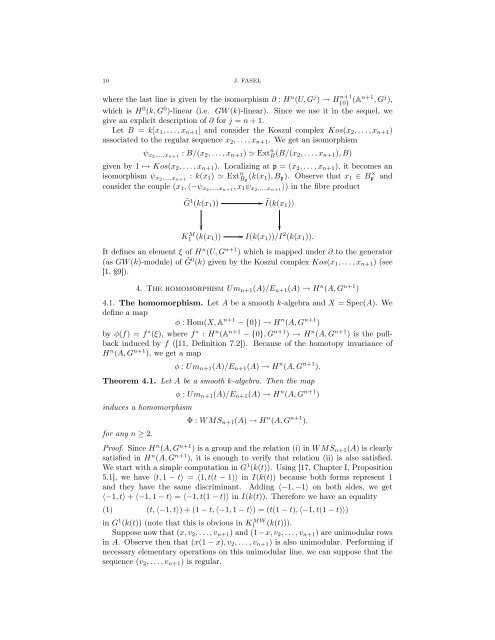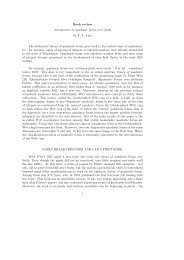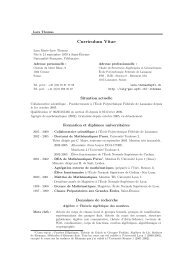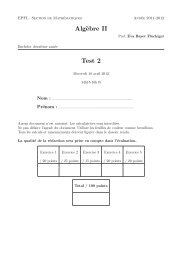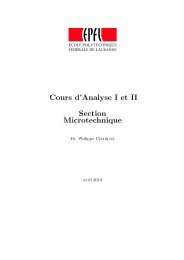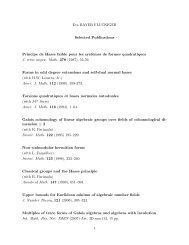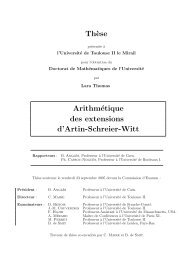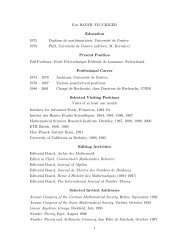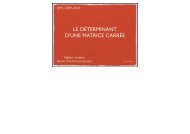Some remarks on orbit sets of unimodular rows - CSAG - EPFL
Some remarks on orbit sets of unimodular rows - CSAG - EPFL
Some remarks on orbit sets of unimodular rows - CSAG - EPFL
Create successful ePaper yourself
Turn your PDF publications into a flip-book with our unique Google optimized e-Paper software.
10 J. FASEL<br />
where the last line is given by the isomorphism ∂ : H n (U, G j ) → H n+1<br />
{0} (An+1 , G j ),<br />
which is H 0 (k, G 0 )-linear (i.e. GW (k)-linear). Since we use it in the sequel, we<br />
give an explicit descripti<strong>on</strong> <strong>of</strong> ∂ for j = n + 1.<br />
Let B = k[x1, . . . , xn+1] and c<strong>on</strong>sider the Koszul complex Kos(x2, . . . , xn+1)<br />
associated to the regular sequence x2, . . . , xn+1. We get an isomorphism<br />
ψx2,...,xn+1 : B/(x2, . . . , xn+1) Ext n B(B/(x2, . . . , xn+1), B)<br />
given by 1 ↦→ Kos(x2, . . . , xn+1). Localizing at p = (x2, . . . , xn+1), it becomes an<br />
isomorphism ψx2,...,xn+1 : k(x1) Ext n Bp (k(x1), Bp). Observe that x1 ∈ B × p and<br />
c<strong>on</strong>sider the couple (x1, 〈−ψx2,...,xn+1 , x1ψx2,...,xn+1 〉) in the fibre product<br />
˜G 1 (k(x1))<br />
<br />
<br />
KM 1 (k(x1)) <br />
I(k(x1))/I2 (k(x1)).<br />
<br />
Ĩ(k(x1))<br />
It defines an element ξ <strong>of</strong> H n (U, G n+1 ) which is mapped under ∂ to the generator<br />
(as GW (k)-module) <strong>of</strong> ˜ G 0 (k) given by the Koszul complex Kos(x1, . . . , xn+1) (see<br />
[1, §9]).<br />
4. The homomorphism Umn+1(A)/En+1(A) → H n (A, G n+1 )<br />
4.1. The homomorphism. Let A be a smooth k-algebra and X = Spec(A). We<br />
define a map<br />
φ : Hom(X, A n+1 − {0}) → H n (A, G n+1 )<br />
by φ(f) = f ∗ (ξ), where f ∗ : H n (A n+1 − {0}, G n+1 ) → H n (A, G n+1 ) is the pullback<br />
induced by f ([11, Definiti<strong>on</strong> 7.2]). Because <strong>of</strong> the homotopy invariance <strong>of</strong><br />
H n (A, G n+1 ), we get a map<br />
φ : Umn+1(A)/En+1(A) → H n (A, G n+1 ).<br />
Theorem 4.1. Let A be a smooth k-algebra. Then the map<br />
induces a homomorphism<br />
for any n ≥ 2.<br />
φ : Umn+1(A)/En+1(A) → H n (A, G n+1 )<br />
Φ : W MSn+1(A) → H n (A, G n+1 ).<br />
Pro<strong>of</strong>. Since H n (A, G n+1 ) is a group and the relati<strong>on</strong> (i) in W MSn+1(A) is clearly<br />
satisfied in H n (A, G n+1 ), it is enough to verify that relati<strong>on</strong> (ii) is also satisfied.<br />
We start with a simple computati<strong>on</strong> in G 1 (k(t)). Using [17, Chapter I, Propositi<strong>on</strong><br />
5.1], we have 〈t, 1 − t〉 = 〈1, t(t − 1)〉 in I(k(t)) because both forms represent 1<br />
and they have the same discriminant. Adding 〈−1, −1〉 <strong>on</strong> both sides, we get<br />
〈−1, t〉 + 〈−1, 1 − t〉 = 〈−1, t(1 − t)〉 in I(k(t)). Therefore we have an equality<br />
(1) (t, 〈−1, t〉) + (1 − t, 〈−1, 1 − t〉) = (t(1 − t), 〈−1, t(1 − t)〉)<br />
in G 1 (k(t)) (note that this is obvious in K MW<br />
1<br />
(k(t))).<br />
Suppose now that (x, v2, . . . , vn+1) and (1−x, v2, . . . , vn+1) are <strong>unimodular</strong> <strong>rows</strong><br />
in A. Observe then that (x(1 − x), v2, . . . , vn+1) is also <strong>unimodular</strong>. Performing if<br />
necessary elementary operati<strong>on</strong>s <strong>on</strong> this <strong>unimodular</strong> line, we can suppose that the<br />
sequence (v2, . . . , vn+1) is regular.


